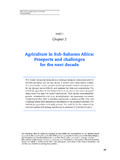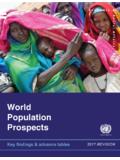Transcription of Food Security and Agricultural Development in …
1 food Security and Agricultural Development in Sub- saharan africa Building a case for more public support Policy Brief No. 1. food Security in sub- saharan africa food Supply Today, almost 33 percent of the population of Cereals, roots and tubers play a central role in sub- saharan africa (SSA), or close to 200 food supply in sub- saharan africa but their million people, are undernourished, of which production has generally lagged behind the rate close to 60 percent are in countries affected by of population growth. Those countries that have conflicts. Chronic undernourishment is been able to increase their cereal production widespread throughout the region, but most of and export Agricultural products have generally the increase in the number of undernourished been those in which food Security improved.
2 To over the last ten years took place in conflict satisfy demand for food , sub- saharan African countries often endowed with abundant countries have had to rely increasingly on mineral resources - while the situation in other imports: 25 percent of cereal consumption is countries has in general improved, although currently imported (compared with 5 percent in unevenly and at a very slow rate. The region as the late sixties). This proportion is much higher a whole remains susceptible to frequent food in poor countries with negative trade balance crises and famines which are easily triggered by and high debt, for which these imports are not even the lightest of droughts, or floods, pests, sustainable.
3 food aid, which had increased economic downturns or conflicts. tremendously in the seventies, has now stabilized and amounts on average to 3 percent Sub- saharan africa is the only region of the of cereal intake. But in some countries, food aid world where hunger is projected to worsen over has become a regular source of supply and its the next two decades unless some drastic proportion in the cereals consumed can be 20. measures are taken to ensure peace, improve percent or more, making these countries governance and achieve the economic dependent on foreign handouts. Development required to reverse the current trend.
4 This policy brief has been prepared by the FAO Policy Assistance Division (TCA) in the framework of the study: food Security and Agricultural Development in Sub- saharan africa : Building a case for more public support, Rome, which will be published in 2006. The study brings together the evidence that justifies a substantial increase in public support, whether financial or of other type, allocated to the sector by governments of African countries. It is based on case studies undertaken in various African countries as well as a Background Study, prepared by CIRAD a synthesis of which is given in Policy Brief No.
5 2. The English versions of the reports prepared for this study are accessible at: French versions will also be accessible in 2006. Similarly, the whole set of reports will be published in 2006. Funding for the study has come partly from the French Ministry of Foreign Affairs (DGCID). The study was shared and discussed with African senior policy makers at a regional workshop organized in Nairobi in September 2005, in collaboration with the NEPAD Secretariat. The views expressed here are those of the authors and do not necessarily reflect the official positions of FAO, the French Government and NEPAD.
6 Access to food Access to food by sub- saharan African As a result of poor transport and market households has been undermined by the infrastructure, food either does not reach those inability of countries to generate the resources who need it most or reaches them at excessively required to import food , a high and increasing high prices. In as many as 17 countries of the level of poverty (50 percent in 2003) resulting region, conflicts have constrained the flow of from overdependence on subsistence food , and, in some cases, it is claimed that food agriculture, limited access to off-farm has even been used as a tool to ensure the employment, sluggish Development in urban submission of populations.
7 Areas and skewed income distribution. The prominent place of agriculture in economic Development , poverty reduction and food Security improvement in sub- saharan africa Improving the food Security situation in sub- are few), and is also the most important source saharan africa requires economic growth and of employment. It has proved to be more higher income, but also immediate measures to effective in reducing poverty than either the ensure adequate access to food for the hungry, manufacturing or service sectors. It can in line with the twin-track approach adopted by stimulate the Development of rural non-farm the three Rome-based agencies: the food and activities, which generate income for the poor if Agriculture Organization of the United Nations care is given that benefits are not reaped by the (FAO), the International Fund for Agricultural better-offs.
8 Finally, it can also generate capital Development (IFAD) and the World food surplus, release labour for other sectors and Programme (WFP). Access to food through provide a stable food supply at affordable prices, social programmes can enable the vulnerable to thus contributing to the competitiveness of the seize economic opportunities that may arise economy as a whole and acting as a major from Development initiatives. source of stimulus for the demand for goods and services of other sectors. To achieve the most direct reduction of poverty and hunger, priority must be given to economic In most African countries, agriculture must growth in sectors where the poor work; that use necessarily be - as various high-level meetings factors of production the poor and have found, including the African Union Summit undernourished possess; that generate outputs in Maputo in 2003 - the priority sector, they consume; and whose Development occurs particularly in the poorer countries, to achieve in areas where they live.
9 Agriculture meets all the first Millennium Development Goal (MDG) of these criteria, and has proved its ability - in hunger and poverty reduction and to significantly africa as well as elsewhere - to act as a lead contribute to the achievement of the other sector for initiating rapid growth and broad- MDGs. To be sustainable, Agricultural based economic Development in the medium- Development needs to be supported by broader term, particularly in less-advanced countries. It Development initiatives in the rural areas and holds a prominent place in the economies of other economic sectors.
10 Sub- saharan African countries and constitutes the primary source of export earnings in all but the mineral-rich and developed countries (which The performance of agriculture in sub- saharan africa Unfortunately, performance of agriculture in sub- growth has averaged around percent. saharan africa has not been up to expectations Contrary to the widespread perception that and has been characterized over the decades agriculture actually has performed worse after by ups and downs. But in recent years, annual the implementation of structural adjustment 2. programmes, evidence shows that sub- saharan This is encouraging for the future as it shows africa 's agriculture grew more than 1 percent that agriculture can be successful in sub- faster since the mid-eighties than during the saharan africa .)













